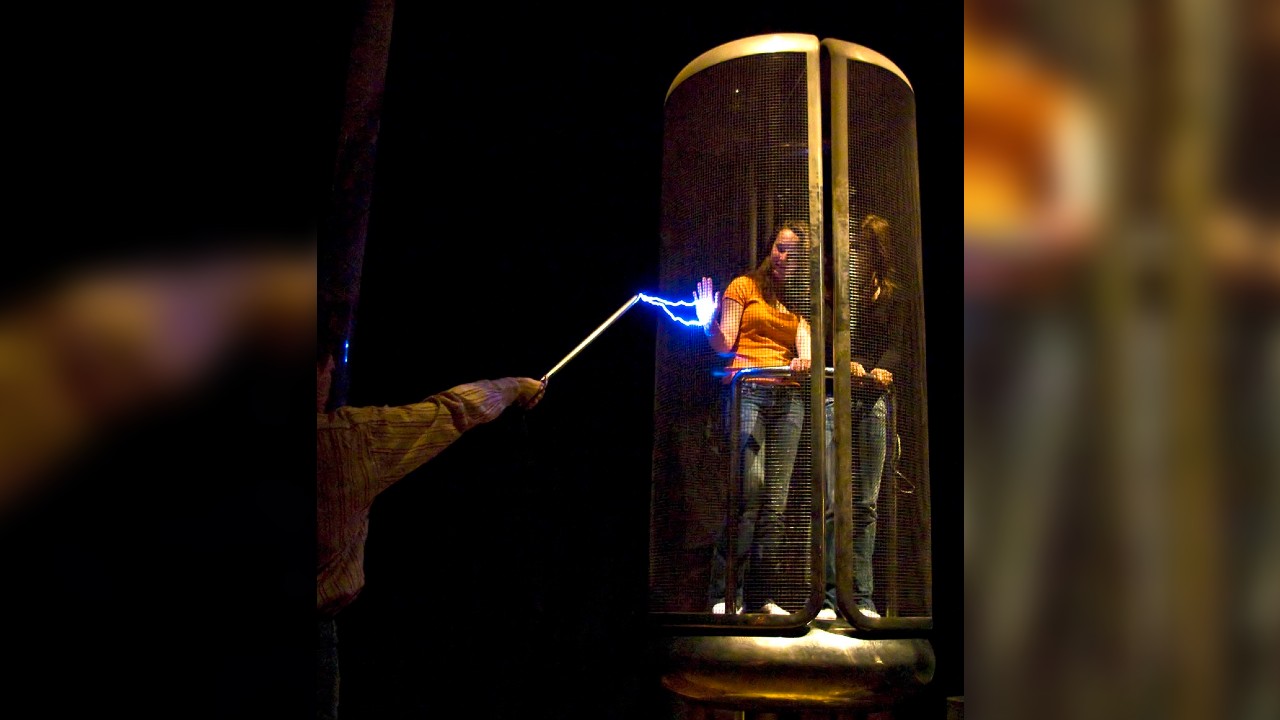What is a Faraday cage?
How does a Faraday cage work and what do we use them for?

A Faraday cage is a protective enclosure that prevents certain types of electromagnetic radiation from entering or exiting, according to the Florida State University Magnetic Field Laboratory. First invented in the 19th century, the cage has a number of practical uses — and some fun applications, too.
We use Faraday cages on a fairly regular basis in places like hospitals and even your kitchen. Some Faraday cages are better than others, but they all follow the same principles.
Here's what a faraday cage is exactly, how it works, and how we use it in everyday life.
Related: Who invented the light bulb?
How does a faraday cage work?
A Faraday cage is essentially a container, or a shield, that blocks out electromagnetic radiation from across the electromagnetic spectrum, such as radio waves and microwaves, according to Florida State University.
It works on the principle that when an electromagnetic field hits something that can conduct electricity, the charges remain on the exterior of the conductor rather than traveling inside.
In more practical terms, that means that a cage constructed of a material that can conduct electricity will prevent certain electromagnetic radiation from passing through. This applies to both constant, or static, electric fields, and changing, or non-static, electric fields.
Who invented the Faraday cage?

British scientist Michael Faraday — who is also known for the Faraday law of induction — invented the Faraday cage in the 19th century, building on work from the American scientist Benjamin Franklin in the previous century.
In 1755, Franklin realized that when he lowered a cork ball on a silk thread into a metal can, with an electric charge running through it, the cork ball was not electrified when lowered into the bottom of the can, according to the National Archives.
Later, in January 1836, Faraday moved into the theater at The Royal Institution in London, where he had been working in the basement, The Guardian reported. Inside the theater, he built a 12-foot cube with a wooden frame on four glass supports. He lined the cube's paper walls with metal foil. And then, apparently he stepped inside, used an an electrostatic generator to blast the room with electricity, and nearly lived there for two days. Inside the box, Faraday discovered what he suspected all along — that electricity is a force and not a material liquid that flowed through wires like water through a pipe, as had been thought at the time, The Royal Institution reported.
Inside the "cage," Faraday's electroscope detected no electricity; only the metal foil surrounding the room conducted electricity, thus showing the concept of a Faraday cage, according to Florida State University.
What are Faraday cages made of?
A Faraday cage can be made of any material that can conduct electricity. This could be a wire mesh, metallic sheets or coils of wire.
They can be any shape, such as a box, sphere or a cylinder, and any size, from extremely small to extremely large. Something as simple as aluminum foil can provide the exterior of the cage, according to Florida State University.
The outer covering, or conductor, can be extremely thin, like foil, but making it thicker will provide additional protection from more powerful electric fields.
What are some examples of Faraday cages?
Faraday cages can be somewhat complex, or extremely simple; they can range from the size of a shoebox to an entire building. Wrap your phone in plastic and then surround that with aluminum foil, for example, and that is a makeshift Faraday cage.
If you have a microwave in your kitchen, that in itself is a form of a Faraday cage, keeping microwaves trapped inside the machine so that they heat your food and do not escape out, according to the journal Physics Education.
On a bigger scale, Magnetic Resonance Imaging (MRI) scanners in medical settings use Faraday cages to prevent radio signals from entering the room and interfering with the equipment, which is , according to MRI scanner manufacturers EEP.
Is a car a faraday cage?
Sort of. If lightning struck your car, the car’s exterior would likely keep you safe from the electric charges involved as its exterior can conduct electricity.
The rubber tires of the car allow the electricity from the lightning strike to pass into the ground, removing the charge from the car, according to Encyclopedia Britannica.
Cars, however, are not perfect examples of Faraday cages. If you were touching any metal connected to the outside of the car when the lightning struck, the results could be extremely dangerous. You can also still get a signal on your phone while inside a car, for example, meaning some electromagnetic radiation can get in and out.

Does a faraday cage need to be grounded?
Grounding a faraday cage — that is, providing a way for the electric charge from its exterior to exit — is important in terms of safety, but it is not necessary for a Faraday cage to operate.
Without grounding, electric charge will remain in the exterior of a Faraday cage. If you were to touch it, this could allow the charge to pass into you, which would be very dangerous.
Grounding the cage provides a means for the charge to exit. This can be in the form of a wire to take the charge away, or something as simple as the tires on a car connected to the road.
Are Faraday cages illegal?
Not really. For the most part they are fine, and they can be seen used in a variety of different settings like we've explained previously.
However, some countries like the UK prohibit the use of jamming devices to block signals, like from a phone. While faraday cages are technically legal, their use in such a scenario could be questionable, according to the U.K. Office of Communications (Ofcom).
In 2016, for example, a bar in the U.K. used a Faraday cage to block mobile phone signals to stop customers from looking at their phones; they created the Faraday cage by installing copper wire mesh into the ceiling of the bar and metal foil into the walls, NPR reported.
Do Faraday cages block Wi-Fi?
Yes, if you surround your Internet router with a Faraday cage, it will no longer be able to transmit electromagnetic radiation outside, blocking your access to the Internet, according to Popular Mechanics.
While it might be an interesting experiment, there is no practical reason for wanting to do so — unless, like a certain bar, you simply want people in your home to stop using their phones.
Related: 5G Network: How does it work, and is it dangerous?
Would a Faraday cage protect from an EMP?
An electromagnetic pulse (EMP) is a weapon designed to neutralize electronic equipment by using a powerful electric field to create short-circuits in such equipment, according to the Washington State Department of Health.
A Faraday cage would be able to prevent such an attack. However, given the strength of the electric field involved in an EMP, such a cage would need to be as water tight as possible with thick, conductive sides and no holes that could let a charge inside.
While EMPs can be the result of weapons, natural events such as solar flares from our sun can also generate them, making Faraday cages a potentially useful tool in protecting us from such occurrences.
Additional resources
Sign up for the Live Science daily newsletter now
Get the world’s most fascinating discoveries delivered straight to your inbox.

Jonathan O’Callaghan is a freelance space and science journalist based in the UK. He specialises in covering commercial spaceflight, space exploration and astrophysics, but also reports across a wide range of science, from CRISPR to climate change. Jonathan’s work has featured in Scientific American, Nature, New Scientist, The New York Times, Quanta, Forbes, Wired, and a variety of other publications. He has also made TV and radio appearances as a space expert for the BBC and other organisations.










